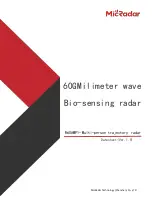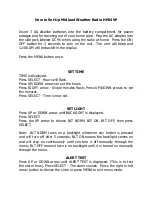
6
Rear Panel Layout
5.0 FAMILIARIZING YOURSELF WITH THE RD
-
1
1) Selector
2) OLED Display
3) CATS
-
EYE
VU Meter
4) Volume Control
(Input Selector)
5) Remote Sensor
6)
Antenna Jack
7)
Inputs: AUX, Line In
8)
Line Out (Preamplifier)
9)
Headphone Jack
10)
input Voltage Selector
11)
IEC AC Power Input
Receptacle
12) Main Power/On/Off
Switch
TUBES:
A) 6N1
B) 6E2 (Cats
-
Eye VU Meter)
C)6N2
Front Panel Layout
1
2
3
4
5
6
7
8
9
10
11
12
7
6.0 SYSTEM CONNECTIONS
6.1 The RD
-
1 is a stand alone Radio with built
-
in speakers but does provide
for connection to other audio components that you may wish to use.
(Example: CD Player connected to Line Input via a pair of good quality RCA
terminated shielded cables.) The RD
-
1 also has a pre
-
amplifier output. You
may also use the RD
-
1 to connect to your smartphone device and where the
RD
-
1 acts as Bluetooth Speaker. (more on this later)
6.2 Connect the Radio to the antenna supplied with the RD
-
1.
6.3 With all input and output connections made, select the proper input AC
mains Voltage by sliding the voltage selector to the proper AC Voltage setting.
6.4 Use the supplied AC power cable connecting it to the IEC receptacle
located on the rear panel of the integrated amplifier’s chassis. Ensure that the
AC wall outlet you use has a functioning ground. Then, it is preferable that
you plug your RD
-
1 into a surge suppressor power bar used as well for your
other audio components, then best is to connect this directly into a dedicated
AC outlet. Best to avoid using an extension cord.
NOTE: In order to obtain the maximum performance from your audio system
we strongly recommend that the detachable power cord does not come into
physical contact with any of the interconnect cables running to and from your
RD
-
1. In the event that this can’t be avoided, you should ensure that any ca-
bles coming into contact with each other are crossed at ninety degree angle to
minimize the contact area.
6.5 Insert the batteries into the Remote Control, Connect the antenna to the
Receiver
Remote Control
1)
Mute
2)
Line input Selector
3)
FM Radio Input Selector
4)
DAB Digital Input Selector
5)
AUX Input Selector
6)
USB DAC Input Selector
7)
Volume Up
8)
Volume Down
9)
Channel Up
10)
Channel Down
11)
Enter Key
12)
Menu Key
13)
Scan Key
14)
EQ Equalizer Key
15)
Information Key
16)
Dimmer Button
17)
Numerical Keys
18)
Preset Select Key
19)
Clock Key
1
2
3
4
5
6
7
8
9
10
11
13
12
15
17
18
14
16
19























